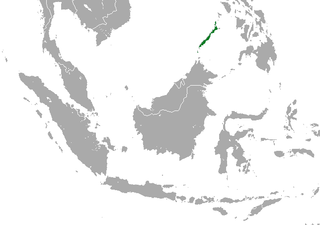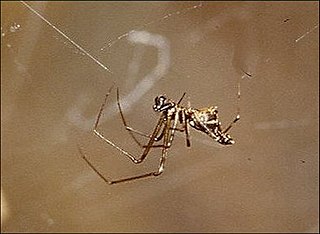
Herring are forage fish, mostly belonging to the family of Clupeidae.

Wobbegong is the common name given to the 12 species of carpet sharks in the family Orectolobidae. They are found in shallow temperate and tropical waters of the western Pacific Ocean and eastern Indian Ocean, chiefly around Australia and Indonesia, although one species occurs as far north as Japan. The word wobbegong is believed to come from an Australian Aboriginal language, meaning "shaggy beard", referring to the growths around the mouth of the shark of the western Pacific.

The conservation status of a group of organisms indicates whether the group still exists and how likely the group is to become extinct in the near future. Many factors are taken into account when assessing conservation status: not simply the number of individuals remaining, but the overall increase or decrease in the population over time, breeding success rates, and known threats. Various systems of conservation status are in use at international, multi-country, national and local levels, as well as for consumer use such as sustainable seafood advisory lists and certification. The two international systems are by the International Union for Conservation of Nature (IUCN) and The Convention on International Trade in Endangered Species of Wild Fauna and Flora (CITES).

Argyrodes, also called dewdrop spiders, is a genus of comb-footed spiders that was first described by Eugène Louis Simon in 1864. They occur worldwide, and are best known for their kleptoparasitism. They can spin their own webs, but tend to invade and reside in their hosts' webs. This relationship can be commensal or even mutual if the dewdrop spider feeds on small trapped insects that are not eaten by the host. Some species can even prey upon the host.

The pygmy round-eared bat is a bat species from South and Central America.

Niceforo's big-eared bat is a bat species from South and Central America, ranging from Chiapas to Bolivia and northeastern Brazil. Its habitat is primary and secondary forest at altitudes from sea level to 1000 m. It is crepuscular, being most active in the hour after sunset and before dawn. The species is monotypic within its genus.

The Tai forest tree frog is a species of frog in the family Arthroleptidae. It is found in Liberia, southern Ivory Coast, and Ghana. Records from Nigeria are controversial and may refer to other species, possibly Leptopelis boulengeri.

The Palawan shrew is a species of mammal in the family Soricidae. It is endemic to the Philippines and known from Palawan and Balabac Islands, from sea level to 1,300 m (4,300 ft) asl. It occurs in old growth and scrubby secondary forest.

The Aldabra flying fox is a species of megabat in the genus Pteropus. It is endemic to the Aldabra Atoll in the Seychelles, like Chaerephon pusilla, though the latter may be the same species as the little free-tailed bat.

The Ontong Java flying fox is a species of flying fox in the family Pteropodidae. It is endemic to the Ontong Java Atoll in the Solomon Islands. Its natural habitats are subtropical or tropical dry forests and subtropical or tropical swamps. It was classified as "Critically Endangered" in 2021 by the IUCN. Its confirmed range extends only over small islands, all of which are near to sea level. It is threatened by rising sea levels.

The Sumatran giant shrew is a shrew of the genus Crocidura. It is native to the Indonesian island of Sumatra, where it is found both in the rainforests to the west of the island and in the hillsides in the south and east. The shrew can be found up to approximately 2,000 metres (6,600 ft) above sea level but is most common at 1,500–1,800 metres (4,900–5,900 ft) above sea level.

Nepenthes monticola is a tropical pitcher plant known from a number of mountains in the west central highlands of western New Guinea, where it grows at elevations of 1400–2620 m above sea level. Prior to its description as a species in 2011, N. monticola was lumped with the closely related N. lamii.

Nepenthes alzapan is a tropical pitcher plant native to the Philippine island of Luzon. It is known from only a handful of herbarium specimens collected in 1925 from submontane mossy forest at an elevation of 1800 m above sea level. It is closely allied to N. bellii and has similarly diminutive pitchers.

Argyrodes cognatus is a species of tangle-web spider that is endemic to the Seychelles, and can be found on Mahé, Conception, Silhouette and Marianne islands. It is found in woodland habitats where it spins orb webs in herbaceous vegetation. It is threatened by habitat deterioration due to invasive plants, especially Cinnamomum verum.
Argyrodes fissifrontellus is a species of tangle-web spider that is endemic to the Seychelles, and can be found on Mahé and Silhouette islands. It is found in woodland areas where it spins orb webs in vegetation, or is a keptoparasite in red-legged golden orb-web spider webs. It is threatened by habitat deterioration due to invasive plants, especially Cinnamomum verum.
Argyrodes rostratus is a species of tangle-web spider that is endemic to the Seychelles, and can be found on Mahé, Île Sèche, Cerf, Conception, Silhouette, Curieuse, Cousin, Aride, Praslin, La Digue, Grand Sœur, Felicite, Marianne, Denis islands and the Alphonse and St. François atolls. It is found in woodland, shrubby habitat and gardens, and is a kleptoparasite of red-legged golden orb-web spiders. It is threatened by habitat deterioration due to invasive plants, especially Cinnamomum verum.
The Papua grassland mosaic-tailed rat, also known as the grassland melomys, is a species of rodent in the family Muridae. It is endemic to the island of New Guinea where it is present from sea level to altitudes of about 2,200 metres (7,200 ft). It inhabits grassland, gardens and other disturbed areas.
Nepenthes armin is a tropical pitcher plant native to the Philippines. The type specimen was collected in 1989 on Sibuyan Island, at an elevation of 750 m above sea level. The specific epithet armin honours Armin Rios Marin.
Nepenthes tboli is a tropical pitcher plant native to the Philippines. The type specimen was collected in 1993 around Lake Parker, T'Boli, South Cotabato, Mindanao, at 1,463 m (4,800 ft) above sea level.

Trujillo's yellow bat or Trujillo's house bat is a species of vesper bat endemic to Kenya.















